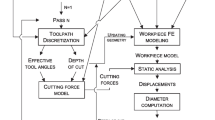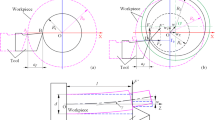Abstract
On the basis of analyzing the machine-workpiece-tool system, the main factors affecting diameter errors in bars turning are considered, and the mathematic models of the actual workpiece diameter at the cutting point are established according to the three usual methods of mounting workpieces on a turning machine. Further a prediction system for diameter errors is developed; a new method, called discrete nodes output, is presented and applied to expressing workpiece diameter errors at given points along the part axis, then off-line compensation is implemented according to the prediction values to diminish machining errors. The results indicate that the method can diminish diameter errors more than 70%, greatly improve the machining accuracy of bars.
Similar content being viewed by others
References
Lechniak Z, Werner A, Skalski K, et al. Methodology of off-line software compensation for errors in the machining process on the CNC machine tool[J]. Journal of Materials Processing Technology, 1998, 76: 42–48.
ZHAO Hang, YAO Ying-xue, LI Jian-guang. Prediction and compensation of machining errors for turning of slender shafts[J]. Journal of Harbin Institute of Technology, 2004, 36(6): 799–801. (in Chinese)
Yang S, Yuan J, Ni J. Real-time cutting induced error compensation on a turning center[J]. International Journal of Machine Tools and Manufacture, 1997, 37: 1597–1610.
Kops L, Gould M, Mizrach M. Improved analysis of the workpiece accuracy in turning, based on the emerging diameter [J]. ASME Journal of Engineering for Industry, 1993, 115: 253–257.
Kops L, Gould M, Mizrach M. Search for equilibrium between workpiece deflection and depth of cut: key to predict compensation for deflection in turning[J]. Manufacturing Science and Engineering ASME-PED, 1994, 68(2): 819–825.
Mayer J R R, Phan A V, Cloutier G. Prediction of diameter errors in bar turning: a computationally effective model[J]. Applied Mathematical Modeling, 2000, 24: 943–956.
Phan A V, Cloutier G, Mayer J R R. Afinite element model with closed-form solutions to workpiece deflections in turning multi-diameter bars[J]. International Journal of Production Research, 1999, 4: 138–142.
Cloutier G, Mayer J R R, Phan A V. Singular function representation in obtaining closed-form solutios to workpiece deflections in turning multi-diameter bars [J]. Computer Modeling and Simulation in Engineering, 1999, 4: 133–137.
Stephenson D A, Bandyopadhyay P. Process-independent force characterization for metal cutting simulation[J]. Concurrent Product and Process Engineering, 1995, 85: 15–36.
Tarng Y S, Wang T C, Chen W N, et al. The use of neural networks in predicting turning forces [J]. Journal of Materials Processing Technology, 1995, 47: 273–289.
Tamas S. Cutting force modeling using artificial neural networks [J]. Journal of Materials Processing Technology, 1999, 92: 344–349.
AI Xing, XIAO Shi-gang. Machining Process Handbook[M]. Beijing: China Machine Press, 1985. (in Chinese)
WU Zhen-yong, WANG Guo-feng, WANG Tai-yong. Study on three dimensional real-time simulation system of NC cutting[J]. Chinese Journal of Mechanical Engineering, 2002, 38(12): 107–110. (in Chinese)
LU Bi-hong, GE Yan-jun, WANG Qi-yi, et al. Study on the precision prediction for virtual NC turning[J]. Chinese Journal of Mechanical Engineering, 2002, 38(2): 82–85. (in Chinese)
YANG Guo-zhe, GE Yan-jun, WANG Wan-shan. Study on the disposal of physical information in virtual turning[J]. Machine Tool and Hydraulics, 2002, 2: 18–20. (in Chinese)
YAO Ying-xue, Lee Wing-bun. Development of a virtual machining and measuring cell for machining quality prediction [J]. China Mechanical Engineering, 2000, 11(5): 520–524. (in Chinese)
Author information
Authors and Affiliations
Corresponding author
Additional information
Foundation item: Projects (50175081 and 50475117) supported by the National Natural Science Foundation of China; project (033181611) supported by the Tianjin Municipal Science and Technology Commission
Rights and permissions
About this article
Cite this article
Fan, Sb., Wang, Ty., Wang, Wj. et al. Prediction of diameter errors compensation in bars turning. J Cent. South Univ. Technol. 12, 264–268 (2005). https://doi.org/10.1007/s11771-005-0056-3
Received:
Accepted:
Issue Date:
DOI: https://doi.org/10.1007/s11771-005-0056-3




